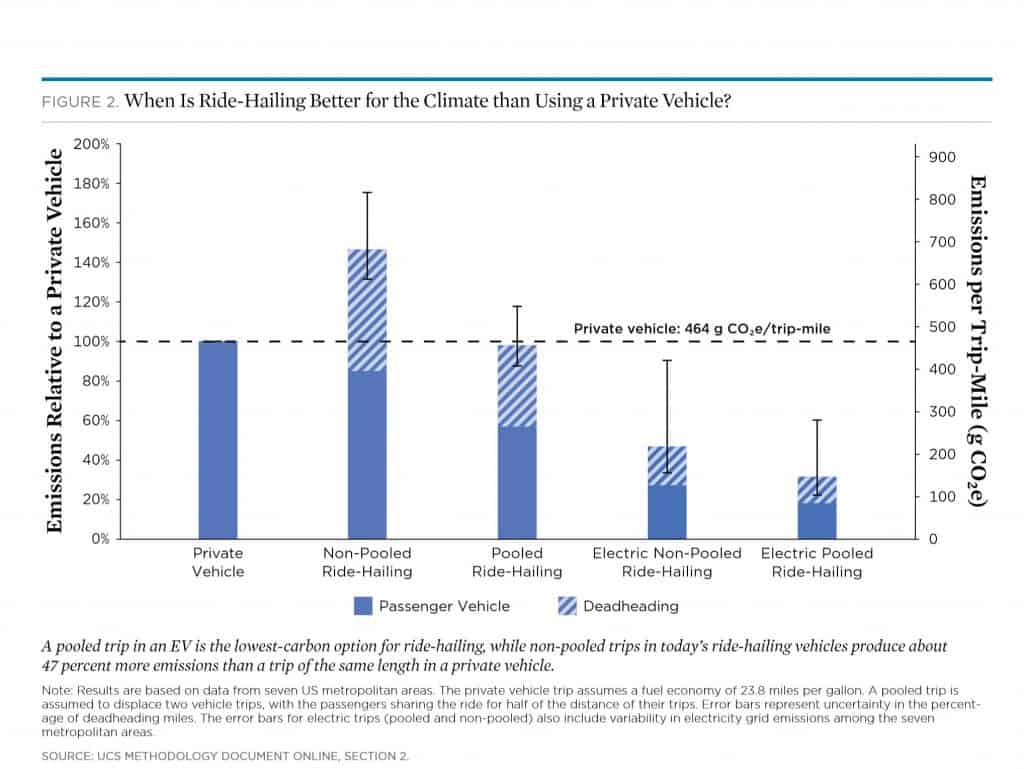 According to the Union of Concern Scientists’ ride-hailing trips today result in an estimated 69 percent more climate pollution on average than the trips they displace.
According to the Union of Concern Scientists’ ride-hailing trips today result in an estimated 69 percent more climate pollution on average than the trips they displace.
While the average ride-hailing vehicle is newer and more fuel-efficient than the average personally owned vehicle, the extra miles associated with deadheading result in higher per-trip emissions. This is particularly true for non-pooled rides, when passengers travel directly to a destination without stopping to pick up other passengers. Based on publicly available ride-hailing data for seven major US metropolitan areas, as well as data from several other sources, UCS estimates that a non-pooled ride-hailing trip generates about 47 percent greater emissions than does a private car trip in a vehicle of average fuel efficiency.
That said, replacing personal car trips with ride-hailing can be a good choice for the climate when customers pool rides or use ride-hailing to connect with mass transit, or when ridehailing drivers use electric vehicles (EVs). Ride-hailing has made it easier to “pool” a ride, with two or more travelers going in a similar direction and sharing a trip.2 When two travelers share a ride-hailing vehicle for at least half of their trip, it can essentially eliminate the climate disadvantage of ride-hailing compared with two private car trips (and compared with a non-pooled ride-hailing trip has about 33 percent lower emissions). Ride-hailing can also facilitate the use of mass transit, by mass transit. When most of the trip is on mass transit, with at most a short connection by ride-hailing, the overall trip is less polluting than traveling the whole distance by car.
While electrifying ride-hailing can significantly reduce cli-mate pollution, such trips still increase total vehicle miles and congestion, which can increase the global warming and air pollution from other cars that get stuck in traffic. Moreover, traffic congestion has additional negative impacts, including increases in noise, crashes, and difficulty in biking or walking. Also, the burdens of increased driving and congestion are not confined to drivers or distributed equally across racial groups; disproportionately, they harm the health and quality of life of people living close to heavily traveled and congested roads (Reichmuth 2019).Because ride-hailing displaces a mix of private car trips and cleaner travel modes and increases deadheading miles, it increases the total amount of car traffic, especially in urban areas where ride-hailing has grown most rapidly. One study found that ride-hailing in urban areas adds about 2.6 miles for each mile of personal driving it replaces (Schaller 2018).
Electrifying ride-hailing and increasing the number of rides that are pooled are essential actions for managing the industry’s climate pol-lution. However, those strategies alone will address neither the increases in vehicle miles traveled nor rising congestion concerns. For ride-hailing to contribute to better climate and congestion outcomes, trips must be pooled and electric, dis-place single-occupancy car trips more often, and encourage low-emissions modes such as mass transit, biking, and walking.
The report recommends:
The ride-hailing industry must take strong action to promote ride pooling, electrify vehicles, and facilitate connections to mass transit.
Governments must provide the public with access to high-quality, multimodal transportation choices, prioritize the movement of people over cars, and ensure that all modes reduce pollution.
They must adapt the rules of the road—for ride-hailing companies, mass transit, and other road users—to ensure access for everyone to safe, equitable, efficient transportation.
Conscientious consumers can help, by making smart trip choices that lessen emissions and traffic congestion and by encouraging companies to offer cleaner option.